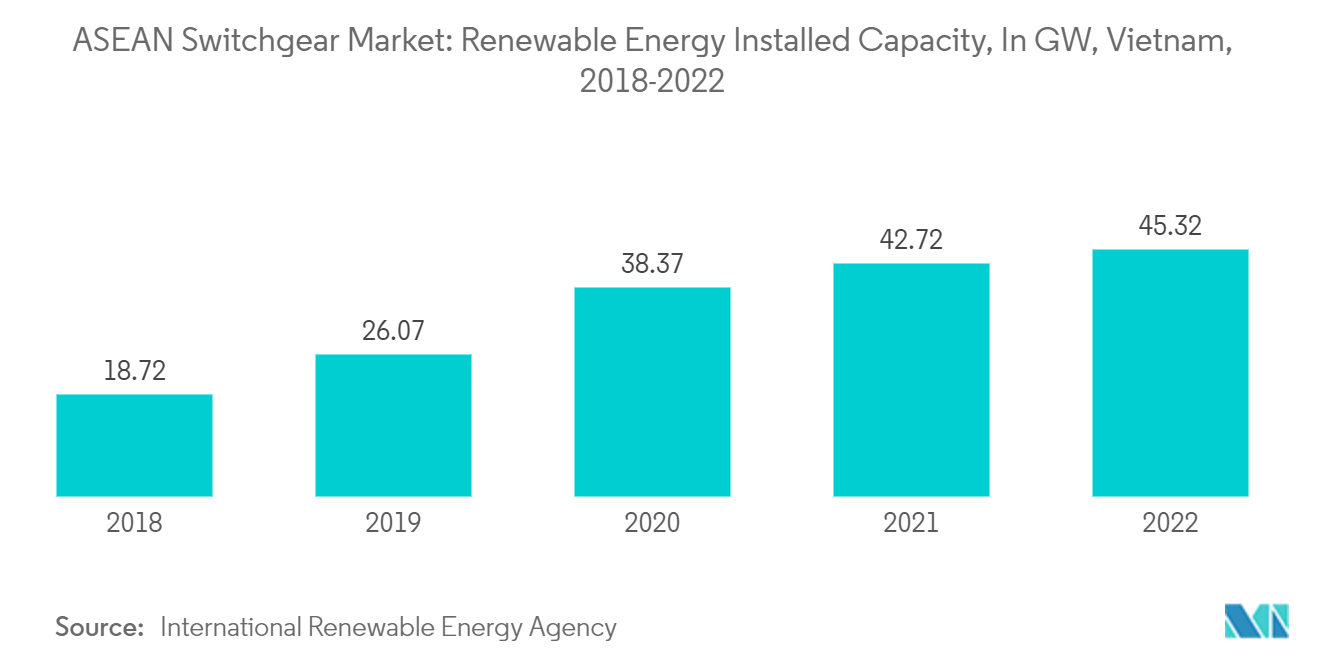Market Trends of ASEAN Switchgear Industry
Utility Segment to Dominate the Market
- The ASEAN region, which consists of 10 Southeast Asian countries, experienced a significant increase in electricity demand over the past few years. It is due to population growth, urbanization, and economic development.
- According to the ASEAN Centre for Energy, the total electricity demand in the ASEAN region is projected to increase to 1,822 TWh in 2040, representing a compound annual growth rate of 4.4%. ASEAN countries are investing in various measures to increase their electricity generation capacity, improve the efficiency of their power systems, and promote the use of renewable energy sources to meet this increasing demand.
- According to BP's statistical review of world energy in 2021, the electricity generation in major ASEAN countries such as Indonesia, Malaysia, Philippines, Singapore, Thailand, and Vietnam was recorded at 1071.8 TWh, an increase of almost 4.6% compared to 2020.
- Furthermore, increasing electricity demand allowed various countries to import energy from neighbouring countries to meet their energy demands. With this import, new transmission and distribution networks are being developed, increasing the demand for switchgear in the region.
- For instance, in June 2022, Singapore's government initiated its initial renewable energy electricity import through a multilateral power trade with neighbouring countries to address its increasing energy demand. The Lao PDR-Thailand-Malaysia-Singapore Power Integration Project (LTMS-PIP) will upgrade its existing transmission and distribution systems to import up to 100 MW of renewable hydropower from Lao PDR to Singapore through Thailand and Malaysia.
- Therefore as per the abovementioned points, the utility sector will likely dominate the switchgear market during the forecasted period.

Vietnam to Witness Significant Growth
- Vietnam's electricity generation, transmission, distribution, and consumption processes are all changing dramatically. Electricity markets, particularly transmission and distribution networks, are restructured to establish an advanced transmission and distribution infrastructure.
- According to the Institute of Energy of Vietnam, the country is expected to face a surge in demand for electricity. It will be due to an increasing population and urbanization, resulting in increased construction and manufacturing activities. The Government of Vietnam expects power consumption to grow 10-12% annually throughout 2030.
- Improper grid infrastructure and the increasing power demand need to be met with the current capacity. The country plans investments to set up and modernize power generation, transmission, or distribution networks to fulfill the rising request. Moreover, the increasing adaption of renewable energy in the electricity generation mix is also expected to increase the upgradation of the transmission and distribution sector in the country, consequently driving the demand for switchgear in the region.
- According to IRENA, Vietnam's installed renewable energy capacity increased by more than 6% between 2021 and 2022. In 2022 the installed renewable energy capacity was around 45,32 GW. A similar trend of growth is estimated during the forecasted period.
- For instance, in July 2022, a collaboration agreement was signed between NovaWind, the wind power arm of ROSATOM, and An Xuan Energy representatives for developing a wind farm in Vietnam. The agreement outlines a partnership to construct a wind farm of 128 MW capacity in the Son La Province, located in the northwestern region of Vietnam.
- Therefore, due to the abovementioned points, Vietnam is expected to witness significant growth during the forecasted period.



